Cold Steel: Revolutionary
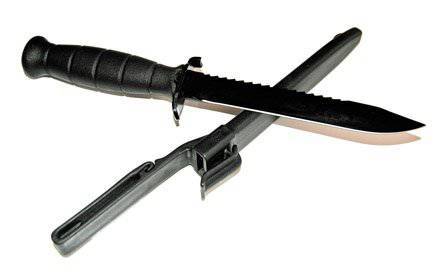
In 1977, the re-equipment of the Austrian army began with StG 77 assault rifles (AUG), which at that time had a mass of ultrafashionable innovations. When they entered the troops, the Austrian soldiers were expecting another surprise - the traditional bayonet-knife was not attached to the new weapon, like the old StG 58 rifle (FAL). The Austrian leadership considered the bayonet to be an untimely and inhumane weapon, encouraging the aggressiveness of servicemen and not fitting into the strictly defensive doctrine of “armed neutrality”. The fact that such a decision was made by politicians far from the realities of the army was quite obvious - in the course of its evolution, the bayonet from cold weapons was transformed into a multi-purpose tool, which became an indispensable companion to the soldier. Therefore, the Austrian military had to urgently correct their mistake and additionally include a knife in the army's supply program.
Several companies took part in the announced competition, including Austrian Ludwig Zeitler, Glock GmbH and German Eickhorn, who offered practically twin knives. Their external and constructive similarities (for example, the handles of all the knives were completely identical) were determined by the requirements of the Austrian army, prescribing the use of certain materials, design elements, etc. In the design of the knife, the soldiers of the Austrian army special forces, the so-called "Yagdkommando" (Jagdkommando , or abbreviated as JaKdo).
Initially, preference was given to the knife Zeitler 77, which was even released a small experimental series. But because of the unexpected bankruptcy of the company Zeitler was forced to prematurely leave the distance of the competitive marathon. The Zeitler 77 knife was notable for its high-quality workmanship and could even be attached to the StG 77 rifle as a bayonet (the diameter of the internal cavity in the handle exactly matched the outer dimensions of the choke), but for the Austrian military this advantage — for the reasons mentioned above — did not have much .
The contract for the supply of knives for the armed forces was awarded to the Austrian company Glock, which at that time was not engaged in the production of pistols, but specialized in the manufacture of various military equipment, such as machine-gun belts, sapper blades and other tools. The Glock knife, which received the official designation FMsr 78 (“Feldmesser 78” is a field knife of the 1978 model of the year, but more often uses the FM abbreviation 78), had a simpler design, weighed less than its competitors, it was easier to attach to uniforms. In addition, the shape of the edge of the blade - in Zeitler 77, it was made in the form of "pike nose" - was more resistant to fracture.
Three years later, the FM 81 model appeared, which differed from the FM 78 knife in the presence of a saw on the blade's butt. In their catalogs, Glock calls the saw version a survival knife, but true survival knives have more functions and, in my opinion, should still be made of stainless steel. Knives 78 and 81 have a blade of ordinary steel, due to which their price lies within the euro 30. At the same time, for its value category, the quality level of Glock knives deserves all praise and has few competitors in terms of price / quality ratio.
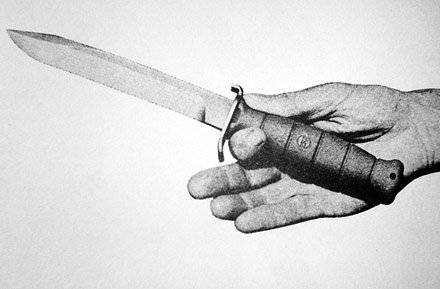
So the Austrian exhortation to FM 78 recommends taking the correct hold of the knife
Both versions of the knife are available in three versions, differing in the color of the plastic parts. They can be black, olive or sand color, which corresponds to the most common colors of uniforms. The armament of the Austrian army was adopted model 78 in the performance of olive color. The 81 model for the supply of the army did not arrive, because, due to the presence of the saw on the butt, it may, according to the Hague Convention 1899 of the year, be classified as a weapon “that causes the affected person unnecessary suffering”. Back in the First World War, the soldiers tried to avoid using so-called combat engineer bayonets with a saw in hand-to-hand combat - an inevitable reprisal awaited someone captured with such a weapon.
The Eickhorn FM 80 knife was released in Solingen by a small commercial party and, like the Zeitler 77 (FM 77 army designation), is today a rarity.
Design
The total length of the knife is 290 mm, weight - 202 gram. Model FM 78 weighs over a gram of 4 more. The blade of a knife with a length of 165 mm is made of 1095 spring carbon steel, heat-treated to a hardness of approximately 55 HRC units. Maximum width of the blade 22 mm, maximum thickness 5,0 mm. To protect against corrosion, a black oxide coating is applied to its surface. The hardness of the HRC 55 is slightly lower than the usual hardness of the blade blades, which usually lies within 58 ... 62 Rockwell units. However, it would be a mistake to assume that Glock used low-quality steel for the blade. Austrian designers deliberately went for some decrease in hardness, making the blade more elastic and less fragile. In addition, the blade of such steel delivers less problems when sharpening. However, the instruction of the Austrian army does not recommend unnecessarily sharply sharpening the blade of the blade in order to avoid possible cuts during careless handling of the knife. It is also recommended, if possible, to protect the protective coating from damage, but this recommendation is very difficult to observe: the Glock knife was created solely for work, and not as an object to decorate collection shelves.
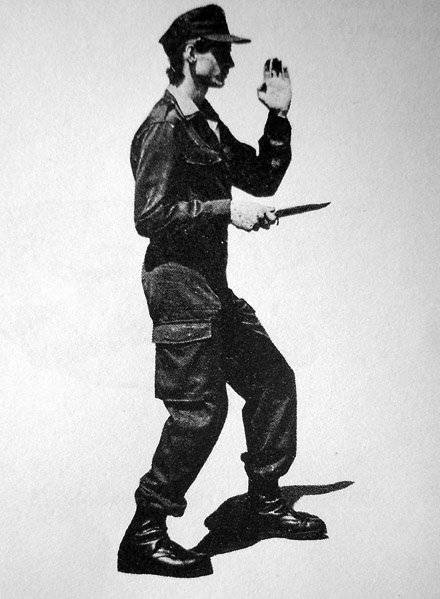
Correct stance when using a knife in hand-to-hand combat
Since the blade is made of ordinary, not stainless steel, it requires a little more care and attention. After each application, it is recommended to thoroughly clean the blade and wipe it dry, and, if possible, apply a thin layer of lubricant to its surface, for example, ballistol.
The side profile of the blade (clip-point, also called "bowie") resembles in its shape many modern bayonet-knives. However, the use of FM 78 and FM 81 knives as a bayonet was not envisaged - the hole in the bayonet handle, unlike the Zeitler 77, does not match its dimensions to the seats on the barrel of the StG 77 and StG 58 rifles.
The knife handle, 125 mm long, is made of polyamide of the same brand as the Glock pistol frame. This material has high mechanical strength, wear resistance, as well as resistance to aggressive media. The surface of the handle is rough to the touch, which allows you to securely hold the knife in your hand. The reliability of the grip is further enhanced by five transverse annular grooves on its surface. The cavity inside the handle is very tightly closed with a plastic lid, so it is problematic to use it as a canister for survival tools. However, the hollow handle of the knife was not intended for this purpose, but is a rudiment of the "bayonet" past knife.
The crosshair of a knife is a stamped part and therefore looks not so aesthetically pleasing, but for a tactical knife this can hardly be considered a disadvantage. One end of the crosshair is curved so that it forms a support for the thumb, being at the same time a bottle opener.
The sheaths of the Glock, weighing just 45 g, are unique, they have no metal parts and are completely made of plastic. Latch the sheath is made in the form of a simple plastic tide in the form of a console, on which sits a button-lock. Initially, this design inspired fear, but over time it became clear that these fears were in vain and the button acts absolutely reliably. The plastic loop for attaching the knife serves as a continuation of the latch and allows it to be hung on a waist belt up to 60 mm wide. In the Austrian army, the instructions allow for a different way of carrying a knife - on the chest, with the handle down (this method is even more popular among the Austrians than the traditional method of fastening on a belt). Initially, in this case, it was recommended to fasten the sheath to the unloading belts with adhesive tape, as, for example, did the Bundeswehr soldiers trying to adjust bayonet knives from Kalashnikovs to the NATO shoulder-shoulder systems. However, later adapters with a rubber loop for attaching the scabbard in this way appeared.
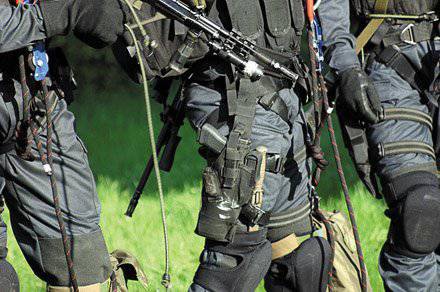
Knife "Glock" - an indispensable attribute of equipment fighters "Yagdkommando"
At the bottom of the sheath there are two holes: a “drainage” rectangular for removing moisture accumulated in the sheaths and a round one for attaching the cord, which serves for additional fixation of the sheath. You can put a knife in the sheath by either side, but the blade sits in them is not very tight and knocks on the walls with shaking.
In the service of special forces ...
In the special forces, Glock knives are common and popular no less than the guns of this Austrian company. But finding information on their use is not so easy, since in many countries of the world special forces are decentralized and their fighters have the right to acquire weapons and equipment on their own. Well, not all of them, for obvious reasons, willingly show themselves and their weapons. Nevertheless, some information was obtained.
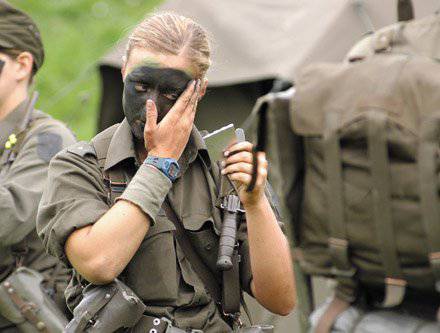
Mountaineer Sabrina Aygen became the first woman who managed to successfully complete the training course of the fighter "Yagdkommando". From now on, women in Austrian special forces are no longer a curiosity.
First of all, we should mention the Austrian army’s “Jagdcommando” mentioned above, who took part in the process of creating the knife. The Austrian army special forces were created in 1963 year to carry out various missions both in the country and abroad. Currently actively used in various peacekeeping missions, in particular, the fighters "Yagdkommando" commanded to the Balkans, to Afghanistan and Chad. So the Glock knives have been tested in various conditions.
It should be noted that in the Austrian army every soldier receives a tactical knife, unlike, for example, from the Bundeswehr, where such knives are the prerogative of elite special forces or units operating in crisis regions (ordinary soldiers are content with folding knives).
Since 1980, the Glock knives are also in service with the special units of the Austrian police. In particular, the 78 and 81 models (in olive version) were purchased for the Cobra antiterrorist group. In addition, the fighters acquired knives of both versions of the Glock and in the black version, since this version is more suited to the dark uniform of special forces. Thus, the Cobra has knives of all modifications without exception.
At the beginning of 80's, the revolutionary developments of Glock GmbH, the Glock-17 pistol (P80) and the FM 78 / 81 tactical knife (both versions), which used a number of unconventional innovations and materials, attracted the attention of GSG-9 employees. A new Austrian pistol with a plastic frame and a knife in a light plastic sheath weighed just 875 g - as much as 415 g (!) Less than a set of Walther P1 pistol and a regular BW-Kampfmesser army knife, armed with the Bundeswehr and federal the police. For these reasons, the German task force has become one of the regular customers of the Gaston Glock company, making the latter a good advertisement. Glock knives have been used by GSG-9 fighters for more than 20 years, and only in 2003 was it decided to replace them.
In 1996, the Glock became the regular knife of the royal armed forces of Denmark, where it received the designation Feltkniv M / 96. A different designation and Danish stamps contributed to the spread of misconceptions about the licensed release of knives in Denmark. However, sources in the Glocke itself claim that the Austrian company did not transfer licenses for the production of knives and they are made exclusively in Austria.
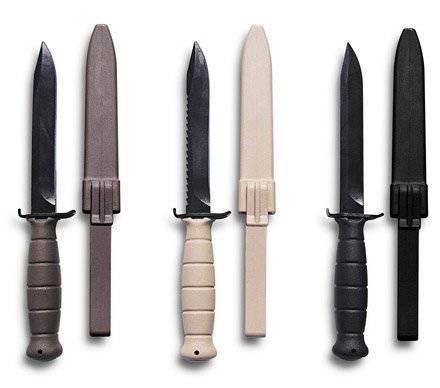
Options for the execution of knives «Glock»
Among other countries whose armed forces and security forces use knives "Glock", can be called Argentina and Ukraine (Department "Falcon" UBOP UMVD). In addition, the Glock knife was used as a prototype by the designers of the Tula TsKIB SOO when creating the OC-4 army knife.
The paper
The Glock FM 78/81 is a true all-rounder for a wide variety of applications. It can be used to cut ropes, bands, ropes, rubber hoses, automotive and aviation seat belts, wire, tarpaulin and other materials. When searching for and defusing mines, the knife can be used as an impromptu probe if there are no suitable means at hand. It can be useful for opening closures, various packaging (eg food rations) and even opening bottles. You cannot do without it - as a cutting, chopping, burrowing and sawing tool - when equipping a firing position, a bivouac or making a path through dense vegetation. When conducting operations inside buildings or vehicles, the tactical knife can be useful for breaking glass, opening locks and doors, etc. Although the Glock is not a hunting knife, it can be used quite successfully for cutting and skinning captured game. And, of course, if the need arises, FM 78/81 can be used as a survival knife or a weapon of self-defense.
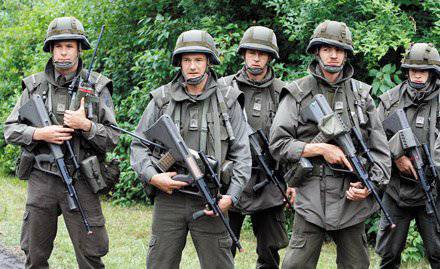
Austrian soldiers with Steyr StG 77 rifles (AUG) and Glock FM 78 knives
Unlike many other tactical knives, the Glock is quite suitable for use as a throwing weapon. It is even reported that this requirement was made by special units of the Austrian army during the development of the knife. In this case, the 78 model in this case is more preferable, since the saw teeth do not interfere with the retention of the knife by the blade. Interestingly, the instruction of the Austrian army prohibits the use of a knife for throwing. This has its own logic: to throw a knife at an enemy protected by body armor and numerous equipment means to leave yourself without the last means of defense. To master the art of precision throwing a knife, long training sessions are required, and teaching them all soldiers is an unaffordable luxury. The special forces and reconnaissance, which are obliged to possess the whole arsenal of means and methods of warfare, are another matter, and knife throwing is one of the traditional types of combat training. So the above prohibition is not connected with the design features of the Glock, but with an extremely narrow and limited scope of this tactical technique.
Revolutionary
Formally, the Glock FM 78/81 was not the very first example of a tactical knife - experts in the field of melee weapons, perhaps, can oppose it with a number of earlier models with certain characteristic features of this type of weapon. For example, the Austrian knife is in many ways similar to the American M3 trench knife and the domestic scout knife HP-43 "Cherry" during the Second World War. However, it was the Glock firm that, having released on the market a massive and inexpensive knife, which was widely used in the armed forces and other law enforcement agencies, as well as in the civilian market, made a revolutionary breakthrough, becoming for a long time one of the trendsetters of the knife fashion. Here it is appropriate to draw a parallel with the Glock-17 pistol, which also revolutionized the arms market at one time. Like its knife brother, the legendary Austrian pistol for the first time collected a lot of "new products", which, in fact, were not new products and had been known for a long time. The plastic frame has already been used in the Heckler & Koch VP 70 pistol, the trigger safety in Stechkin's firing cigarette case, the high-capacity magazine in the Browning HP pistol, etc. But who would deny the importance of the Glock-17's role in the development modern short-barreled weapons? All of the above applies equally to the Glock knives, which have rightfully become revolutionaries of the knife market.
Information